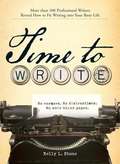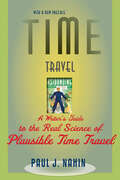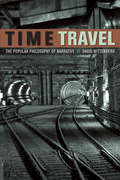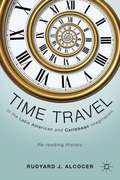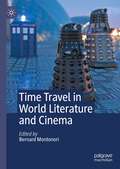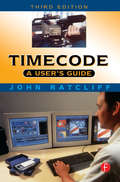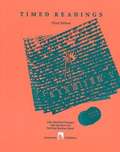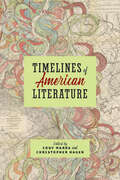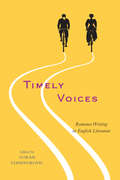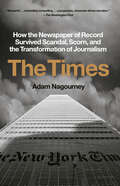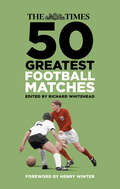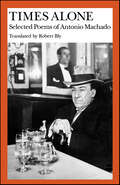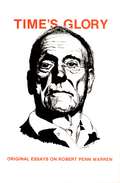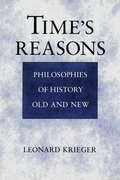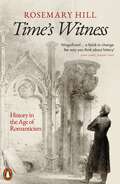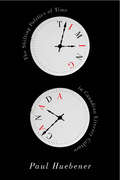- Table View
- List View
Time, the City, and the Literary Imagination (Literary Urban Studies)
by Anne-Marie Evans Kaley KramerTime, the City, and the Literary Imagination explores the relationship between the constructions and representations of the relationship between time and the city in literature published between the late eighteenth century and the present. This collection offers a new way of reading the literary city by tracing the ways in which the relationship between time and urban space can shape literary narratives and forms. The essays consider the representation of a range of literary cities from across the world and consider how an understanding of time, and time passing, can impact on our understanding of the primary texts. Literature necessarily deals with time, both as a function of storytelling and as an experience of reading. In this volume, the contributions demonstrate how literature about cities brings to the forefront the relationship between individual and communal experience and time.
Time To Know Them: A Longitudinal Study of Writing and Learning at the College Level
by Marilyn S. SternglassIn a time of declining resources in institutions of higher education, we grapple with how priorities are to be set for the limited resources available. Most vulnerable are those students labeled underprepared by colleges and universities. Should we argue that the limited resources available ought to be used to support these students through their undergraduate years? And, if we decide that we want to do that, what evidence of their potential for success can we provide that will justify the use of these resources? Through longitudinal research that follows students who have been so labeled over all their college years, we can begin to find answers to these questions. Time to Know Them is the first book that follows the experiences of a group of students over their entire academic experience. No previous studies have brought together the factors incorporated in this study: *examining writing and learning on a true longitudinal basis; *studying a multicultural urban population; *investigating the relationship between writing and learning by examining papers written over time for regularly assigned academic courses across a range of disciplines; and *taking into consideration non-academic factors that influence academic performance such as race, gender, socio-economic status, and ideological orientation. Through interviews twice a semester over six years, the collection of papers written for all courses, observations of instructional settings, and analysis of required institutional tests of writing, the author has been able to pull together a more complete picture of writing and intellectual development over the college years than has previously been available in any study. Students are seen to acquire the ability to handle more complex reasoning tasks as they find themselves in more challenging intellectual settings and where risk-taking and exploration of new ideas are valued. The integration of students' previous life experiences into their academic studies allows them to analyze, critique, modify, and apply their previously held world views to their new learning. These changes are seen to occur over time with instructional settings and support providing key roles in writing development. Personal factors in students' lives present difficulties that require persistence and dedication to overcome. Never before have the complexities of real individual lives as they affect academic performance been so clearly presented.
Time to Tug
by Paula LaRosa Cindy PeattieTitle contained within StartUp Phonic Core Program. Not Sold Separately
Time to Write
by Kelly L Stone"Okay, no more excuses. Light bulbs went off in my head as I read Kelly L. Stone's Time to Write with its shrewd observations and sage, practical advice for making time to write."-HALLIE EPHRON, author of Writing and Selling Your Mystery Novel. "When it's a writing day, I'm writing. Period." - JODI PICOULT. "If the trouble is just getting started in the morning, I often change my writing place or method." -JENNIFER BLAKE. In Time to Write, more than 100 professional writers from across genres-including Sandra Brown, Catherine Coulter, Wendy Corsi Staub, Merline Lovelace, Steve Berry, Tess Gerritsen, Ann Major, Cherry Adair, Christine Feehan, Julia London, and Eloisa James-share their secrets to finding time to write. And if they could find the time to write, then so can you. The time is now.
Time to Write
by Kelly L. Stone"Okay, no more excuses. Light bulbs went off in my head as I read Kelly L. Stone's Time to Write with its shrewd observations and sage, practical advice for making time to write. "-HALLIE EPHRON, author of Writing and Selling Your Mystery Novel. "When it's a writing day, I'm writing. Period. " - JODI PICOULT. "If the trouble is just getting started in the morning, I often change my writing place or method. " -JENNIFER BLAKE. In Time to Write, more than 100 professional writers from across genres-including Sandra Brown, Catherine Coulter, Wendy Corsi Staub, Merline Lovelace, Steve Berry, Tess Gerritsen, Ann Major, Cherry Adair, Christine Feehan, Julia London, and Eloisa James-share their secrets to finding time to write. And if they could find the time to write, then so can you. The time is now.
Time Travel: A Writer's Guide to the Real Science of Plausible Time Travel
by Paul J. NahinFrom H.G. Wells to Isaac Asimov to Ursula K. Le Guin, time travel has long been a favorite topic and plot device in tales of science fiction and fantasy. But as any true SF fan knows, astounding stories about traversing alternate universes and swimming the tides of time demand plausible science. That’s just what Paul J. Nahin’s guide provides.An engineer, physicist, and published science fiction writer, Nahin is uniquely qualified to explain the ins and outs of how to spin such complex theories as worm holes, singularity, and relativity into scientifically sound fiction. First published in 1997, this fast-paced book discusses the common and not-so-common time-travel devices science fiction writers have used over the years, assesses which would theoretically work and which would not, and provides scientific insight inventive authors can use to find their own way forward or backward in time. From hyperspace and faster-than-light travel to causal loops and the uncertainty principle and beyond, Nahin’s equation-free romp across time will help writers send their characters to the past or future in an entertaining, logical, and scientific way.If you ever wanted to set up the latest and greatest grandfather paradox—or just wanted to know if the time-bending events in the latest pulp you read could ever happen—then this book is for you.
Time Travel: The Popular Philosophy of Narrative (Gothic Fantasy Ser.)
by David WittenbergThis book argues that time travel fiction is a narrative “laboratory,” a setting for thought experiments in which essential theoretical questions about storytelling—and, by extension, about the philosophy of temporality, history, and subjectivity—are represented in the form of literal devices and plots.Drawing on physics, philosophy, narrative theory, psychoanalysis, and film theory, the book links innovations in time travel fiction to specific shifts in the popularization of science, from evolutionary biology in the late 1800s, through relativity and quantum physics in the mid–20th century, to more recent “multiverse” cosmologies. Wittenberg shows how increasing awareness of new scientific models leads to surprising innovations in the literary “time machine,” which evolves from a “vehicle” used chiefly for sociopolitical commentary into a psychological and narratological device capable of exploring with great sophistication the temporal structure and significance of subjects, viewpoints, and historical events.The book covers work by well-known time travel writers such as H. G. Wells, Edward Bellamy, Robert Heinlein, Samuel Delany, and Harlan Ellison, as well as pulp fiction writers of the 1920s through the 1940s, popular and avant-garde postwar science fiction, television shows such as “The Twilight Zone” and “Star Trek,” andcurrent cinema. Literature, film, and TV are read alongside theoretical work ranging from Einstein, Schrödinger, and Stephen Hawking to Gérard Genette, David Lewis, and Gilles Deleuze. Wittenberg argues that even the most mainstream audiences of popular time travel fiction and cinema are vigorously engaged with many of the same questions about temporality, identity, and history that concern literary theorists, media and film scholars, and philosophers.
Time Travel in the Latin American and Caribbean Imagination
by Rudyard J. AlcocerCombining in innovative ways the tools and approaches of postcolonial and popular culture studies as well as comparative literary analysis, this is an ambitious, interdisciplinary study that develops - across several related discursive sites - an argument about the centrality of time travel in the Latin American and Caribbean imagination.
Time Travel in World Literature and Cinema
by Bernard MontoneriTime Travel in World Literature and Cinema discusses various literary works, movies, and TV series with a special focus on time travel. Each chapter is written by professors and scholars from various countries, including the US, Japan, Germany, France, Spain, Taiwan, South Africa, Qatar, Russia, Ukraine and Australia. The book addresses themes of racism, sexism, feminism, and social injustice as well as dystopian futures. This will appeal to students and scholars studying science fiction, dystopian literature, world literature, and world cinema.
Timecode A User's Guide: A user's guide (Music Technology Ser.)
by J. RatcliffRecent radical changes in timecode technology, location shooting and post-production working practices have been brought about by the fragmentation of the television programme making industry and by a dramatic increase in affordable digital transmission and editing equipment and systems.With the expansion of non-traditional television service producers (cable, satellite and video-on-demand) almost anything hoes as far as shooting and editing formats are concerned. Timecode: A User's Guide is an indispensable reference for anyone needing to get to grips with the many aspects of timecode, whether in-house or on location.Taking into account these changes this book has now been brought completely up to date to include:* timecode and DVD, LTC & VITC in HANC packets in the serial digital TV interfaces * timecode in IEEE1395 (Firewire)* timecode and digital video cassettes* new recording formats of DVD, DV mini cassettes and D6 are included* 4:3 scanning for wide-screen films - standards updated* new material to cover new working practices* new appendices to cover the global LF time data transmissions and time data embedded in BBC transmissionsAdvice is also given on avoiding and remedying faults and errors.
Timed Readings: Fifty 400-Word Passages with Questions for Building Reading Speed (Book Ten) (Third Edition)
by Edward SpargoDo your students fail to even finish a timed test? Do they read word by word? Do they simply move their eyes over the page, never remembering what they read? If you suspect that students' test scores are being confounded by any of these traits, or if you have students who need to process greater amounts of information, the Timed Readings books can help. For over thirty years, Jamestown has been helping students increase their reading rate and fluency while maintaining comprehension. Timed Readings is the original series of timed reading books; 400-word nonfiction timed passages in science, social studies, the humanities, and more.
Timed Readings: Fifty 400-Word Passages with Questions for Building Reading Speed (Book One) (Third Edition)
by Edward SpargoPrepare your students for timed tests from our largest collection of science, social studies, and literature selections Increase reading stamina Build reading rate and fluency Prepare students for state and national tests Do you have students who simply do not finish the test in the time allotted? Do they move their eyes over the page without remembering what they read? For over 30 years, the Jamestown Timed Readings collection has helped such students increase their reading rate, fluency, and comprehension. The 55 books in the series all have Uniform 400-word passages for easy timing Nonfiction and fiction selections like those found on state and national tests Literal and critical comprehension questions Progress charts for motivation Identical covers within a series so no one is embarrassed Six different series to meet your students' needs Timed Readings Plus in Social Studies, Science, or Mathematics--passages on content area topics like those found on standardized tests Timed Readings in Literature--excerpts from great literature Timed Readings--passages from science, social studies, the humanities, and more Timed Readings Plus--nonfiction passages followed by related fiction
Timeless Voices Timeless Themes: World Masterpieces
by Prentice HallWorld Masterpieces features classic literature dating back nearly 5000 years. The earliest writings of Confucius along with literature from Sumerians and Persians capture themes from the dawn of literary civilization.Works from Japan, Zaire, France, and dozens of other countries show how themes of human life recur in distinct and diverse cultures. Each unit opens with historical, geographical, and cultural background. Special Cross Currents features link ideas from the past to contemporary events relevant to today's students.
Timelines of American Literature
by Cody Marrs and Christopher HagerA collection of engaging essays that seeks to uniquely reperiodize American literature.It is all but inevitable for literary history to be divided into periods. "Early American," "antebellum," "modern," "post-1945"—such designations organize our knowledge of the past and shape the ways we discuss that past today. These periods tend to align with the watershed moments in American history, even as the field has shifted its perspective away from the nation-state. It is high time we rethink these defining periods of American literary history, as the drawing of literary timelines is a necessary—even illuminating—practice.In these short, spirited, and imaginative essays, 23 leading Americanists gamely fashion new, unorthodox literary periods—from 600 B.C.E. to the present, from the Age of Van Buren to the Age of Microeconomics. They bring to light literary and cultural histories that have been obscured by traditional timelines and raise provocative questions. What is our definition of "modernism" if we imagine it stretching from 1865 to 1965 instead of 1890 to 1945? How does the captivity narrative change when we consider it as a contemporary, not just a "colonial," genre? What does the course of American literature look like set against the backdrop of federal denials of Native sovereignty or housing policies that exacerbated segregation? Filled with challenges to scholars, inspirations for teachers (anchored by an appendix of syllabi), and entry points for students, Timelines of American Literature gathers some of the most exciting new work in the field to showcase the revelatory potential of fresh thinking about how we organize the literary past.
Timely Voices: Romance Writing in English Literature
by Goran StanivukovicFrom the fourteenth-century Sir Gawain and the Green Knight to In Parenthesis – an epic poem written in 1937 by painter and poet David Jones – English writers have looked to romance as a resource and a strategy to expand the imaginary reach of their writing. Rethinking the resilience, purpose, and place of romance in English literature, Timely Voices discusses moments that have altered how we read and interpret this ever-changing form. Addressing the various ways in which romance has absorbed and been absorbed by drama, prose, and poetry, contributors to this volume demonstrate that romance texts do not produce something defined or confined by a static genre, but rather express a repository of creative possibilities. Covering writers including the anonymous author of Sir Orfeo, Jane Austen, Geoffrey of Monmouth, Lucy Hutchinson, William Morris, Philip Sidney, William Shakespeare, and Edmund Spenser, essays explore the magic and wonder of romance, Irish and Gaelic lore, how woodcuts in early books complement and extend printed text, how romance was dramatized, how it gives language to feminist politics and ideology, and how it becomes a counterpoint to finance in the fiction of the early Romantic period. A nuanced reinterpretation of romance in its own terms, Timely Voices inspires new appreciation of this form as a solution to textual, aesthetic, structural, ideological, and political problems in literature.
The Times: How the Newspaper of Record Survived Scandal, Scorn, and the Transformation of Journalism
by Adam NagourneyA sweeping behind-the-scenes look at the last four turbulent decades of &“the paper of record,&” The New York Times, as it confronted world-changing events, internal scandals, and faced the existential threat of the internet &“An often enthralling chronicle [that] delivers the gossipy goods . . . Like Robert Caro&’s biographies, [The Times] should appeal to anyone interested in power.&”—Los Angeles TimesA KIRKUS REVIEWS BEST BOOK OF THE YEARFor over a century, The New York Times has been an iconic institution in American journalism, one whose history is intertwined with the events that it chronicles—a newspaper read by millions of people every day to stay informed about events that have taken place across the globe.In The Times, Adam Nagourney, who&’s worked at The New York Times since 1996, examines four decades of the newspaper&’s history, from the final years of Arthur &“Punch&” Sulzberger&’s reign as publisher to the election of Donald Trump in November 2016. Nagourney recounts the paper&’s triumphs—the coverage of September 11, the explosion of the U.S. Challenger, the scandal of a New York governor snared in a prostitution case—as well as failures that threatened the paper&’s standing and reputation, including the discredited coverage of the war in Iraq, the resignation of Judith Miller, the plagiarism scandal of Jayson Blair, and the high-profile ouster of two of its executive editors.Drawing on hundreds of interviews and thousands of documents and letters contained in the newspaper&’s archives and the private papers of editors and reporters, The Times is an inside look at the essential years that shaped the newspaper. Nagourney paints a vivid picture of a divided newsroom, fraught with tension as it struggled to move into the digital age, while confronting its scandals, shortcomings, and swelling criticism from conservatives and many of its own readers alike. Along the way we meet the memorable personalities—including Abe Rosenthal, Max Frankel, Howell Raines, Joe Lelyveld, Bill Keller, Jill Abramson, Dean Baquet, Punch Sulzberger and Arthur Sulzberger Jr.—who shaped the paper as we know it today. We see the battles between the newsroom and the business operations side, the fight between old and new media, the tension between journalists who tried to hold on to the traditional model of a print newspaper and a new generation of reporters who are eager to embrace the new digital world.Immersive, meticulously researched, and filled with powerful stories of the rise and fall of the men and women who ran the most important newspaper in the nation, The Times is a definitive account of the most pivotal years in New York Times history.
The Times 50 Greatest Football Matches
by Richard WhiteheadFrom the earliest FA Cup finals in the 1870s between teams of former public schoolboys to the glittering world of 21st-century Champions League matches contested by squads of millionaires, The Times has been at pitchside to write the history of football as it has happened.It is story of great matches: Hungary’s historic victory over England at Wembley in 1953, Manchester United’s triumph over Benfica in the 1968 European Cup final, Brazil’s thrashing of Italy in the 1970 World Cup final, Liverpool’s remarkable recovery to win the Champions League in Istanbul in 2005. It is a story of dazzling individual performances: Stanley Matthews finally winning an FA Cup winners’ medal at Wembley in 1953, Bobby Moore giving a masterclass in the art of defending for England against Brazil in the 1970 World Cup, Cristiano Ronaldo’s virtuoso performance as Real Madrid won the 2017 Champions League. It is a story of national highs and lows, from Wembley in 1966 when England ruled the world after defeating West Germany to the humiliation of losing to Iceland in the 2016 European Championship.But above all it is a story of great players, great managers and great personalities in a sport that grips the attention of the world like no other.
Times Alone: Selected Poems of Antonio Machado (Wesleyan Poetry in Translation)
by Antonio MachadoAntonio Machado, a school teacher and philosopher and one of Spain's foremost poets of the twentieth century, writes of the mountains, the skies, the farms and the sentiments of his homeland clearly and without narcissism: "Just as before, I'm interested/in water held in;/ but now water in the living/rock of my chest." "Machado has vowed not to soar too much; he wants to 'go down to the hells' or stick to the ordinary," Robert Bly writes in his introduction. He brings to the ordinary—to time, to landscape and stony earth, to bean fields and cities, to events and dreams—magical sound that conveys order, penetrating sight and attention. "The poems written while we are awake…are more original and more beautiful, and sometimes more wild than those made from dreams," Machado said. In the newspapers before and during the Spanish Civil War, he wrote of political and moral issues, and, in 1939, fled from Franco's army into the Pyrenees, dying in exile a month later. When in 1966 a bronze bust of Machado was to be unveiled in a town here he had taught school, thousands of people came in pilgrimage only to find the Civil Guard with clubs and submachine guns blocking their way. This selection of Machado's poetry, beautifully translated by Bly, begins with the Spanish master's first book, Times Alone, Passageways in the House, and Other Poems (1903), and follows his work to the poems published after his death: Poems from the Civil War (written during 1936 – 1939).
Time's Glory: Original Essays on Robert Penn Warren
by James A. Grimshaw Jr.Robert Penn Warren, the first U.S. Poet Laureate, has received every honor this country can bestow on a writer. Warren has written fiction, nonfiction, and poetry, and has proven to be one of the most versatile writers in modern times. Now, seven original essays on Warren's writing, written by leading scholars and students, have been brought together in one volume. In Warren's fiction sloth, or acedia, is the deadliest of sins. Frances Bixler examines this theme as it courses through five novels. World Enough and Time and The Cave both are analyzed in chapters of their own. Warren's volume of poetry Altitudes and Extensions is given a close reading, while his nonfiction works, particularly The Legacy of the Civil War and Jefferson Davis Gets His Citizenship Back, are also critiqued. The breadth and depth of Robert Penn Warren's canon of work are illustrated by the essays collected by James A. Grimshaw, Jr. Although many books have been written on Warren and his work, to cover such a wide range of his work in one volume is a rare achievement. James A. Grimshaw, Jr., is a professor in, and head of, the Department of Literature and Languages at East Texas State University. His publications include Robert Penn Warren: A Descriptive Bibliography and Robert Penn Warren's "Brother to Dragons": A Discussion .
Time's Reasons: Philosophies of History Old and New
by Leonard KriegerThis original work caps years of thought by Leonard Krieger about the crisis of the discipline of history. His mission is to restore history's autonomy while attacking the sources of its erosion in various "new histories," which borrow their principles and methods from disciplines outside of history. Krieger justifies the discipline through an analysis of the foundations on which various generations of historians have tried to establish the coherence of their subject matter and of the convergence of historical patterns. The heart of Krieger's narrative is an insightful analysis of theories of history from the classical period to the present, with a principal focus on the modern period. Krieger's exposition covers such figures as Ranke, Hegel, Comte, Marx, Acton, Troeltsch, Spengler, Braudel, and Foucault, among others, and his discussion involves him in subtle distinctions among terms such as historism, historicism, and historicity. He points to the impact on history of academic political radicalism and its results: the new social history. Krieger argues for the autonomy of historical principles and methods while tracing the importation in the modern period of external principles for historical coherence. Time's Reasons is a profound attempt to rejuvenate and restore integrity to the discipline of history by one of the leading masters of nineteenth- and twentieth-century historiography. As such, it will be required reading for all historiographers and intellectual historians of the modern period.
Time's Witness: History in the Age of Romanticism
by Rosemary HillFrom the Wolfson Prize-winning author of God's Architect: Pugin and the Building of Romantic BritainBetween the fall of the Bastille in 1789 and the opening of the Great Exhibition in 1851, history changed. The grand narratives of the Enlightenment, concerned with kings and statesmen, gave way to a new interest in the lives of ordinary people. Oral history, costume history, the history of food and furniture, of Gothic architecture, theatre and much else were explored as never before. Antiquarianism, the study of the material remains of the past, was not new, but now hundreds of men - and some women - became antiquaries and set about rediscovering their national history, in Britain, France and Germany.The Romantic age valued facts, but it also valued imagination and it brought both to the study of history. Among its achievements were the preservation of the Bayeux Tapestry, the analysis and dating of Gothic architecture, and the first publication of Beowulf. It dispelled old myths, and gave us new ones: Shakespeare's birthplace, clan tartans and the arrow in Harold's eye are among their legacies. From scholars to imposters the dozen or so antiquaries at the heart of this book show us history in the making.
Timing Canada: The Shifting Politics of Time in Canadian Literary Culture
by Paul HuebenerFrom punch clocks to prison sentences, from immigration waiting periods to controversial time-zone boundaries, from Indigenous grave markers that count time in centuries rather than years, to the fact that free time is shrinking faster for women than for men - time shapes the fabric of Canadian society every day, but in ways that are not always visible or logical. In Timing Canada, Paul Huebener draws from cultural history, time-use surveys, political statements, literature, and visual art to craft a detailed understanding of how time operates as a form of power in Canada. Time enables everything we do - as Margaret Atwood writes, "without it we can't live." However, time also disempowers us, divides us, and escapes our control. Huebener transforms our understanding of temporal power and possibility by using examples from Canadian and Indigenous authors - including Jeannette Armstrong, Joseph Boyden, Dionne Brand, Timothy Findley, Lucy Maud Montgomery, Gabrielle Roy, and many others - who witness, question, dismantle, and reconstruct the functioning of time in their works. As the first comprehensive study of the cultural politics of time in Canada, Timing Canada develops foundational principles of critical time studies and everyday temporal literacy, and demonstrates how time functions broadly as a tool of power, privilege, and imagination within a multicultural and multi-temporal nation.
Timing Canada The Shifting Politics of Time in Canadian Literary Culture
by Paul HuebenerFrom punch clocks to prison sentences, from immigration waiting periods to controversial time-zone boundaries, from Indigenous grave markers that count time in centuries rather than years, to the fact that free time is shrinking faster for women than for men - time shapes the fabric of Canadian society every day, but in ways that are not always visible or logical. In Timing Canada, Paul Huebener draws from cultural history, time-use surveys, political statements, literature, and visual art to craft a detailed understanding of how time operates as a form of power in Canada. Time enables everything we do - as Margaret Atwood writes, "without it we can't live." However, time also disempowers us, divides us, and escapes our control. Huebener transforms our understanding of temporal power and possibility by using examples from Canadian and Indigenous authors - including Jeannette Armstrong, Joseph Boyden, Dionne Brand, Timothy Findley, Lucy Maud Montgomery, Gabrielle Roy, and many others - who witness, question, dismantle, and reconstruct the functioning of time in their works. As the first comprehensive study of the cultural politics of time in Canada, Timing Canada develops foundational principles of critical time studies and everyday temporal literacy, and demonstrates how time functions broadly as a tool of power, privilege, and imagination within a multicultural and multi-temporal nation.



